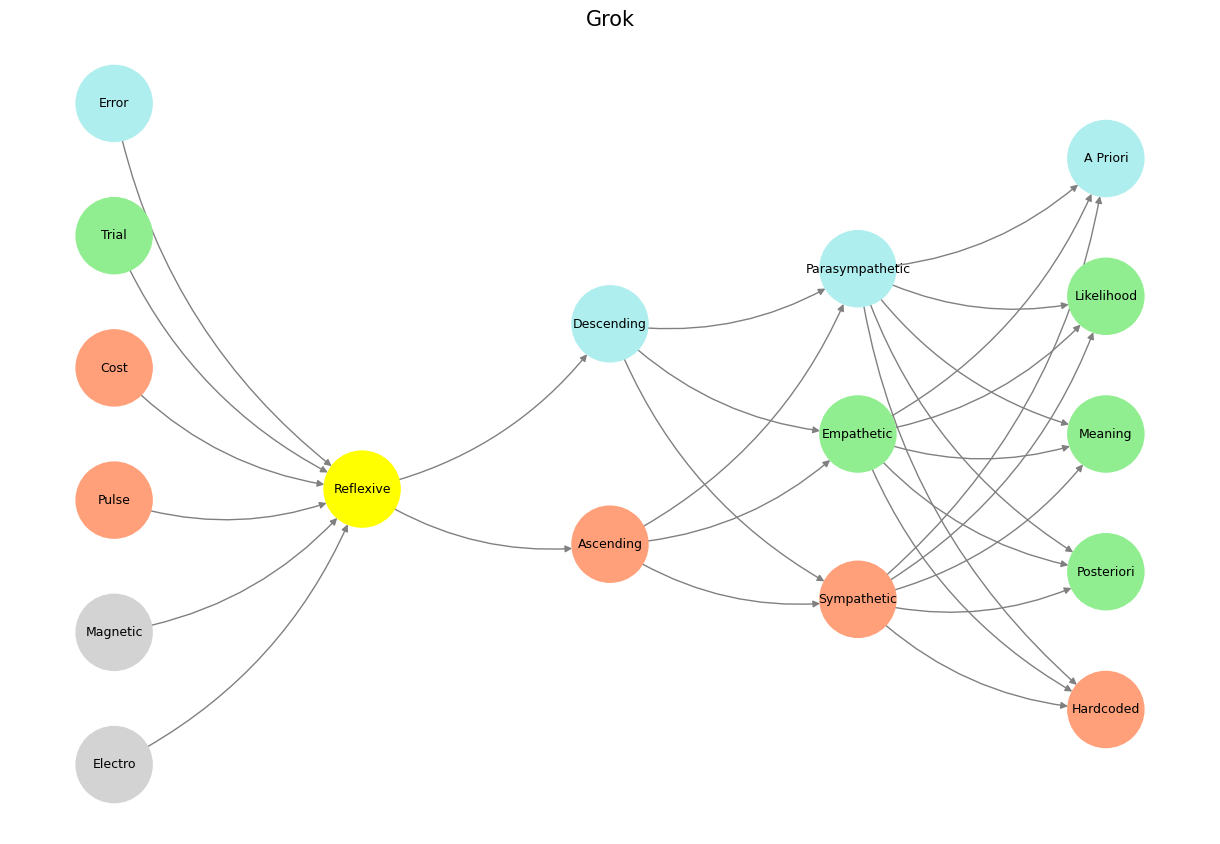Dancing in Chains#
In this neural network where nodes are emotions and edges signify cadences between them, the transitions from one emotion to another provide a rich tapestry of human emotional experience. For instance, the cadence from “Sympathetic” to “Meaning” might encapsulate a journey from empathy towards others’ experiences to deriving profound significance from those encounters. This could evoke a sense of “tragical,” where the connection with another’s pain leads to a deeper understanding of life’s narratives, highlighting the bittersweet nature of human connection.
Moving from “Ascending” to “Empathetic” illustrates a shift where personal growth or joy transitions into an expanded capacity for empathy. Here, the ascent of one’s own emotions might bring about a shared joy or understanding with others, possibly capturing a “comical” or light-hearted cadence. This transition suggests that personal success can foster a communal sense of humor or happiness, where one’s progress becomes a source of collective joy.
Within the “World” layer, the transition from “Trial” to “Error” could reflect the emotional ups and downs of learning and growth. This connection might embody a “historical” cadence, where the excitement of experimentation leads to the sometimes humorous, sometimes painful acknowledgment of mistakes. It’s a reminder of how we learn from our past, seeing the irony or humor in our previous errors as we move forward.

Fig. 28 Inheritence, Heir, Brand, Tribe, Religion. Karoline Leavitt’s voice has a melody, rhythm, timing, and cadence that is comparable to a fledgling pianists first recital. It’s not idiomatic, doesn’t flow, and talking points are repeated in overplus. She’s following a prompt.#
The shift from “Hardcoded” to “Posteriori” in the “Time” layer represents a movement from innate, immediate emotional responses to those informed by experience. This cadence might evoke a “pastoral” sense of peace or nostalgia, where the initial, automatic reactions give way to emotions shaped by the wisdom of life’s lessons. It’s a journey from the immediacy of feeling to a more reflective understanding of one’s emotional landscape.
From “Pulse” to “Cost,” we see an emotional transition from the vibrant, life-affirming energy to the realization of what living fully might cost. This could lead to a more serious or “tragical” mood, where the joy of existence is contrasted with its sacrifices, highlighting the complex interplay between life’s highs and the price they might entail.
Lastly, the cadence from “Magnetic” to “Reflexive” might depict how an attraction or repulsion triggers an immediate, automatic emotional response. This could lean towards a “comical” or ironic outcome, where the pull of attraction leads to unexpected, knee-jerk reactions, illustrating how our instincts can sometimes lead us into humorous or surprising emotional territories.
Each of these cadences within the network provides a pathway for understanding the fluidity and interconnectedness of our emotional lives, showing how one emotion can lead to another, creating narratives or emotional journeys that are as varied as they are profound.
Show code cell source
import numpy as np
import matplotlib.pyplot as plt
import networkx as nx
# Define the neural network fractal
def define_layers():
return {
'World': ['Electro', 'Magnetic', 'Pulse', 'Cost', 'Trial', 'Error', ], # Veni; 95/5
'Mode': ['Reflexive'], # Vidi; 80/20
'Agent': ['Ascending', 'Descending'], # Vici; Veni; 51/49
'Space': ['Sympathetic', 'Empathetic', 'Parasympathetic'], # Vidi; 20/80
'Time': ['Hardcoded', 'Posteriori', 'Meaning', 'Likelihood', 'A Priori'] # Vici; 5/95
}
# Assign colors to nodes
def assign_colors():
color_map = {
'yellow': ['Reflexive'],
'paleturquoise': ['Error', 'Descending', 'Parasympathetic', 'A Priori'],
'lightgreen': ['Trial', 'Empathetic', 'Likelihood', 'Meaning', 'Posteriori'],
'lightsalmon': [
'Pulse', 'Cost', 'Ascending',
'Sympathetic', 'Hardcoded'
],
}
return {node: color for color, nodes in color_map.items() for node in nodes}
# Calculate positions for nodes
def calculate_positions(layer, x_offset):
y_positions = np.linspace(-len(layer) / 2, len(layer) / 2, len(layer))
return [(x_offset, y) for y in y_positions]
# Create and visualize the neural network graph
def visualize_nn():
layers = define_layers()
colors = assign_colors()
G = nx.DiGraph()
pos = {}
node_colors = []
# Add nodes and assign positions
for i, (layer_name, nodes) in enumerate(layers.items()):
positions = calculate_positions(nodes, x_offset=i * 2)
for node, position in zip(nodes, positions):
G.add_node(node, layer=layer_name)
pos[node] = position
node_colors.append(colors.get(node, 'lightgray'))
# Add edges (automated for consecutive layers)
layer_names = list(layers.keys())
for i in range(len(layer_names) - 1):
source_layer, target_layer = layer_names[i], layer_names[i + 1]
for source in layers[source_layer]:
for target in layers[target_layer]:
G.add_edge(source, target)
# Draw the graph
plt.figure(figsize=(12, 8))
nx.draw(
G, pos, with_labels=True, node_color=node_colors, edge_color='gray',
node_size=3000, font_size=9, connectionstyle="arc3,rad=0.2"
)
plt.title("Grok", fontsize=15)
plt.show()
# Run the visualization
visualize_nn()


Fig. 29 G1-G3: Ganglia & N1-N5 Nuclei. These are cranial nerve, dorsal-root (G1 & G2); basal ganglia, thalamus, hypothalamus (N1, N2, N3); and brain stem and cerebelum (N4 & N5). Throughout childhood, one’s hearing will be restricted to sounds between 20Hz-4,000Hz, associated with time of day, landscapes traversed, tribe and ritual, birds in woods, tuning of instruments and speech, and cadences and more. The melodies, rhythms, improvisations, emotions, and cadences that efficiently convey meaning will be communally recognized in pretext, subtext, text, context, and metatext. This is idiomatic speech. Whatever goes wrong that inhibits the same from emerging with music and poetry must be investigated, since these are essentially identical processes relying on the same resources and infrastructure#

